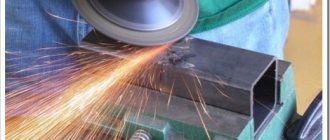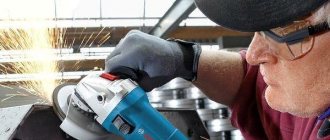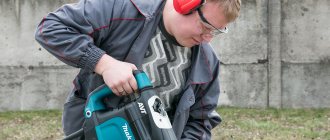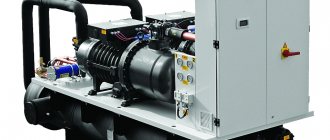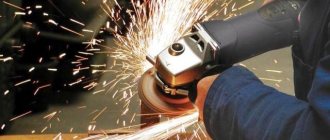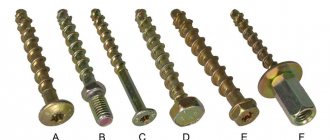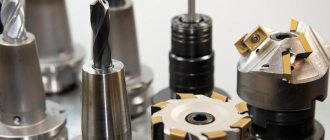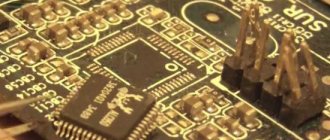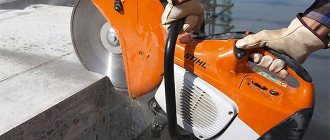Angle grinder (grinder) METABO WE 15-150 Quick. Photo 220Volt
High-quality work and maintaining health in the vast majority of cases when working with an angle grinder depends on understanding its structure and correct working methods . An angle grinder, commonly known as an angle grinder, is a tool that does not tolerate neglect of safety rules . This article will cover in detail all the nuances and techniques of working with an angle grinder, as well as safety standards that require strict compliance.
Why do you need an angle grinder, how to use it, instructions for dummies
The grinder or angle grinder got its name because of the country where its production was established. The first machines were exported to the USSR from Bulgaria ; at that time they were not multifunctional and only allowed for grinding various surfaces. Later , the device of the grinders was modernized and allowed multifunctional use, which will be discussed below.
The Makita GA 6021 C angle grinder is suitable for cutting tiles. Photo VseInstruments.ru
The external structure of the grinder is related to its purpose: an elongated body in which the gearbox and electric motor are located, the body itself has a molding for the handle, a side handle and the grinding disc itself are fixed on the working part, which is covered with a protective case. The versatility of angle grinders is ensured by changing disk attachments , which are selected depending on the type of work and working surface. Discs and attachments are attached to a special seat and screwed with a spindle or a clamping washer.
The main tasks of an angle grinder include : grinding and polishing rough surfaces, cutting ceramics and stone, glass, concrete monolith, wood, etc. - it all depends on the choice of attachment.
Cutting, metal work and more
Cutting metal with a grinder is quite a common procedure. For this purpose, special cutting discs are used : solid, that is, representing a thin circle with one hole for mounting on the spindle, or perforated, which have oblong slots from the edge of the disc to the center. Perforation is necessary for self-cooling of the disk with air.
To master the techniques of working with an angle grinder, you need to familiarize yourself in detail with its structure. Structurally, the tool consists of a mounting head - a spindle on which equipment is placed - wheels for grinding or cutting, an elongated or rectangular body, one or two handles. The equipment depends on the requirements for the types of work using an angle grinder:
- Cutting of all kinds of materials, including high-strength composite alloys.
- Grinding and cleaning of surfaces.
Important! Under no circumstances should you work with an angle grinder if the equipment is not secured to the spindle using a pressure flange and nut. A wrench is used for this.
How to nag from yourself or towards yourself
If the grinder is part of a machine for cutting ceramic, wooden or stone slabs, then cutting towards itself is allowed , subject to two rules:
- The operator's body is located to the side of the cutting line.
- The machine is equipped with additional protective guards that limit the movement of the angle grinder beyond the working area.
If the angle grinder is in the user’s hands and is held only by hand force, then cutting towards oneself is strictly prohibited. All movements on the surface are made strictly from yourself.
Important! The circle on the angle grinder rotates clockwise, if you make movements away from you, then the rotation of the circle and the independent movement of the grinder can combine, an amplifying resonance will arise, and the grinder can “fly out” of your hands. Therefore, it is necessary to hold the instrument firmly in your hands.
Grinding
The classic grinding procedure is carried out as follows: if it is not possible to connect a vacuum cleaner to the casing, then the work must be carried out outdoors . If the work is carried out indoors, then it is better to use some kind of backing material as dust collectors, for example old newspapers. The blade guard must protect the operator and not obstruct vision.
Angle grinder AEG 451410 WS13-125XE in operation. Photo 220Volt
When working, you should adhere to the following methodology:
- The circle is held to the surface at an angle of 3-5 degrees, light back-and-forth movements are performed. If you put pressure on the disc, dents and dents may form on the wood.
- For some types of wood, it is advisable to use discs with different roughness - coarse at the beginning and finely abrasive upon completion of the work.
- If the surface of the wood needs to be varnished, then after the grinder it is better to use a belt or rotary sander.
Polishing
In order to create a polished surface, an angle grinder is first used, then a belt sander, and then liquid varnishes and polishes.
The work is carried out as follows:
- The grinding wheel is used to initially clean the surface. The disk is held in almost complete contact with the surface, the disk operates without pressure from the user.
- Thin sheets of wood or metal are secured with a clamp and placed against the stop.
- Using an angle grinder you can create a perfectly smooth, mirror-like surface of soft wood and metals. But for rocks and varieties that are characterized by increased hardness, additional types of processing will be required.
Stripping
In order to effectively remove varnish or polishing residues, it is necessary to use disc-shaped discs, the surface of which is lined with sandpaper of different roughness.
- The circle is held at an angle of up to 30 degrees and fed in a reciprocating motion without pressure.
- Thin sheets of wood or metal are secured with a clamp and placed against the stop.
- Using an angle grinder, you can only remove the base of the old coating, after which you will still need to be treated with belt sanding.
Cleaning metal with a grinder
Introductory part. Young fighter course
Grinder, also known as angle grinder (angle grinder). Brief information for those who hold this capricious instrument in their hands for the first time.
1.1. Grinder device (angle grinder)
- On/off button
- Spindle stop button (spindle rotation is blocked when the tool is turned off when replacing abrasive discs)
- Lever. Rubberized as in the photo. An angle grinder produces noticeable vibrations during operation.
- Protective cover. Removing it is strictly prohibited!
- Air channels. Try not to overlap them with your palms so as not to overheat the angle grinder.
- Abrasive disc. In this case, grinding.
Do you know why the Bulgarian is called the Bulgarian?
The proper name “grinder” appeared in the 70s of the last century, when the first representatives of this type of instruments, produced in Bulgaria, arrived in the USSR. They were called "Fortune".
Bulgarian, now Sparky, was the first in CMEA to begin production of this type of power tool, purchasing an AEG license in 1966.
1.2. Actions with an angle grinder. What can you twist and change?
Some models provide the design ability to change
1.2.1. Handle position
1.2.2. Guard position
But never remove it completely!
Very conveniently made by the Japanese (Kawasaki). In a couple of seconds you can rearrange without a key.
The click system also looks interesting, but I personally have not had to use it.
Attention!
If you found it in a garage, received it at a factory, borrowed it from a neighbor, or somewhere else you came across a used grinder without a protective cover, then refuse the job or arrange for it to be available. Never work without a protective cover!
1.2.3. Speed adjustment
There are excellent angle grinders on sale with a speed controller. I use it myself and highly recommend it. Economic considerations are also useful here - the consumption of abrasive wheels will be 2-3 times lower.
If your grinder does not know how to regulate the speed itself, then look for an adjustable autotransformer (LATR), many people use homemade ones. With this device you can overcome the frantic speed of the grinder and even turn it into a polishing machine.
1.2.4. Replacing the drive
We change the disk as follows:
- We de-energize the tool (you can simply unplug it from the socket)
- Press the spindle stop (see the grinder device above)
- Use a special wrench to unscrew the lock nut.
This not the most convenient option will be on your grinder by default. When you get tired of turning with a wrench, purchase a modernized nut with a spring-loaded base that clamps the disk. Chinese junk, pay once for AEG, BOSCH or Makita .
Safety precautions
Before work begins, the grinder needs to be prepared : select an attachment and secure it to the spindle. If you are choosing a disk, then you should take into account an important rule: the smaller the diameter of the disk, the higher the rotation speed it can withstand. Therefore, it is necessary to familiarize yourself with the power parameters of the angle grinder . If the disc is selected incorrectly, it may break during operation, and this will also lead to wear on the grinder’s mechanisms.
Important! It is strictly forbidden to mount discs larger than the permissible diameter on the grinder.
Discs with traces of deformation, wear or cracks are immediately rejected and removed from the grinder; their use is prohibited. After securing the disk to the spindle, you need to check that it rotates correctly during idle start . To do this, you need to turn on the grinder and rotate it at full power for 1-2 minutes. It is considered that the grinder is ready for work if, during idle rotation, there is no contact with the body by the disk, vibration or extraneous noise.
Safety goggles with direct ventilation ROSOMZ ZP2 PANORAMA super PC 30130. Photo VseInstruments.ru
It is very important to fill in a number of strict prohibitions:
- You cannot work with a bracelet on your hand or any other jewelry - they can get wrapped around the attachment during operation.
- You must not start work while feeling unwell or intoxicated.
- It is prohibited to mount circular disks for cutting wood on a grinder.
- You cannot drive the grinder along the surface towards you.
- Do not let go of the grinder until the disc stops completely.
- The equipment is not removed until it cools down.
- Do not place fuel cans or other flammable items near the work site.
- You cannot neglect the availability of PPE, a first aid kit and knowledge of safety rules.
Another important condition is securing the surface or part being processed . For this purpose, vices, tripods and clamps are used. As an exception, only those objects that have a large mass and themselves remain immobile during processing can be used. You can also use the help of a partner who will hold the part in compliance with safety rules with an adjustable wrench.
Important! Keeping the part in a canopy is strictly prohibited.
Use of personal protective equipment
The operator of the angle grinder must also prepare his own safety, since the angle grinder casing only protects against sparks and the smallest abrasive fragments. Operator training involves the use of PPE - personal protective equipment:
- Plastic glasses.
- A jacket or shirt with thick sleeves without cuffs.
- Gloves.
- Mask or respirator.
- The respirator will protect the respiratory system from dust from sanding surfaces entering the lungs, and goggles have repeatedly protected the eyes of workers from bounced fragments of the disk or surface being treated.
Open safety glasses SecureFit 201 with 3M transparent lenses. Photo VseInstruments.ru
Place of work
The following mandatory rules apply to the place of work
- No clutter, freedom of movement for the worker.
- Possibility of rapid fire extinguishing.
- Ventilation.
- Availability of power supply.
- Lighting.
These requirements apply directly to the workplace for using an angle grinder, since during operation dust and sparks arise, and the angle grinder itself requires connection to an electrical network.
Securing workpieces
The grinder interacts with disks and other attachments on the working surface, which rotate at very high speed. The rotational movement of the nozzle is transmitted to light workpieces, which, being at rest, receive a translational vector and themselves move in space. To put it simply, a loose part will fly off the workbench if its mass is small and it is not secured. That is why the parts are fastened in a vice or under clamps.
Clamp vice Blacksmith WA1-100. Photo VseInstruments.ru
Operation of a working tool, initial start-up, breaks, where sparks should fly
You should choose a stable position for the body so that sparks do not fly under your feet when cutting. The cord should be strictly behind the body and not touch the working surface, so that there is no danger of it being wound around the circle. When working on the next part or when moving from place to place, the grinder must be turned off. The same should be done during power outages.
Important! Experts clearly recommend following one important rule: the direction of movement of the grinder should be the same as the direction of rotation of the disk. But in this case, sparks will fly onto the part, which may disrupt the view of the markings. But this rule almost completely covers the possibility of the disk getting stuck in the surface being processed.
Rules for using the grinder:
- You need to stand not in front of the grinder, but slightly to the side. This will allow you to protect yourself during the jet movement of the angle grinder in the event of a reverse strike.
- The protective cover protects the worker from injury in 90% of cases by containing the flying disc.
- There is no need to put pressure on the grinder ; it should process the surface under its own weight. The pressure can warp or destroy the disc.
- The grinder does not turn on if the disc is placed in the cut.
- If an angle grinder is used to cut a metal profile, then the cut begins at the thinnest point.
- If stone or ceramics are being cut and dust is generated, then it is better to choose a model with a vacuum cleaner that is connected to the casing.
- Cutting walls is dangerous due to the discovery of hidden cables or other communications. If they are touched, a backlash may occur, so you must stand strictly to the side of the cutting line.
Popular questions
First of all, users are interested in the following questions, which will be answered immediately.
Angle grinder (grinder) BORT BWS-1200U-SR. Photo 220Volt
Question: Can cut-off or sanding discs be used as one attachment to sand or cut different surfaces? That is, is it possible to use one nozzle for all work?
Answer: no, this is strictly prohibited. You won't be able to save money on this.
Question: if continuous home production is organized, how much will the electricity consumption meter count?
Answer: it should be understood that grinders have different powers. For example, for a 1200 W device that will be used continuously for 8 hours a day, the power consumption will be 210 W.
Question: if you buy an industrial grinder for your home, will it last forever?
Answer: industrial electrical appliances and tools are always highly wear-resistant, but one fact should be noted: a number of devices in the industrial sector operate on three-phase voltage. Household sockets are two-phase.
Accidents
As already mentioned, the use of grinders with strict adherence to safety rules is a guarantee of maintaining health, not only your own, but also those of others. If treated negligently, the angle grinder may “lead”, the disc may split or fly off the spindle . If you're lucky, it will fly past, but it can also be stopped... by the human body, which is extremely harmful to health)))
Maintenance and repair of safe angle grinders
If you do not have the skills of an electrician, then all work related to the electrical component, such as cleaning brushes, rewinding the electric motor, etc. – it’s better to entrust it to a professional. But you can check the integrity of the casing, spindle, threads of the clamping nut and flange yourself.
Correct cut
Before you start cutting the product, you need to understand which side is best to do it on. If you have access from all sides, then this is very good, and the likelihood of making mistakes is reduced.
Be sure to consider which direction the disk is spinning. So, when sparks fly from you, then under no circumstances make a “fork” when cutting a channel or metal profile. The photo clearly shows what I mean. You can’t cut like that with a grinder!
When starting to cut metal, the grinder should be positioned so that the cutting part is slightly raised. You need to hold the angle grinder confidently, but when you start cutting metal, you should not put pressure on the product.
Try to keep the device level. This way you will not only get an even cut, but also reduce the likelihood of the disc jamming.
The most important thing is to take into account the basics of physics. The cut element should go to the side and not pinch the disk. It is best to create conditions so that it is suspended. To do this, place something under the product. Example in the photo.
Device, operating principle and application possibilities
With the increase in power, a precedent has emerged for ensuring active and passive safety standards when using this tool. Modern angle grinders are equipped with many practical features and functional designs for working with metal, ceramics, wood and other surfaces.
The device of the grinder DIOLD MSHU-1.5-01. Photo 220Volt
To master the techniques of working with an angle grinder, you need to familiarize yourself in detail with its structure. Structurally, the tool consists of a mounting head - spindle , on which equipment - wheels for grinding or cutting, elongated or rectangular body one or two handles . The equipment depends on the requirements for the types of work using an angle grinder:
- Cutting of all kinds of materials, including high-strength composite alloys.
- Grinding and cleaning of surfaces.
Varieties
Grinders are available in three modifications according to their intended purpose:
- Industrial. They are distinguished by great power, as well as the possibility of long-term use every day, but they cannot be used continuously.
- Household. Their purpose is for occasional use to perform small amounts of work.
- For continuous production. They have a huge service life and are suitable for long-term and daily use.
Angle grinder INGCO AG30008 with a power of 3000 W. Photo VseInstruments.ru
In addition, grinders are divided according to a number of design features . They can be equipped with rotary or removable handles, a removable or built-in casing, and depending on the power, they have different weights and dimensions. The parameters are selected depending on the work for which the angle grinder is needed.
Which disc to cut metal with a grinder
It is equally important to buy wheels for an angle grinder for metal that match the characteristics. When choosing, take into account the diameter and thickness of the products - these parameters determine the maximum depth of the cut.
Cutting wheels of small thickness (1–1.2 mm) are suitable for working with metal workpieces. They allow you to make straight cuts without applying significant effort. For shaped processing of thin rolled metal, metal grinder wheels of the smallest diameter are used.
Photo No. 5: circles for an angle grinder for metal (125 mm)
Next, when choosing a tool for an angle grinder for cutting sheet metal, they focus on the material that needs to be processed. Cast iron, steel, aluminum and brass require different discs. You will find out information about the purpose of a particular product from the markings on the label.
- For stainless steel. Unlike other consumables, discs designed for stainless steel do not damage the protective film on the metal, which protects the material from corrosion.
Photo No. 6: cutting wheel for an angle grinder on stainless steel
- For non-ferrous metals. There are separate varieties for cutting cast iron, aluminum, copper, and brass. Anti-caking additives are added to the composition of wheels that work with soft materials. Products for processing cast iron, on the contrary, have solid diamond inclusions.
Photo No. 7: cutting wheel for an aluminum grinder
- For thin profiles and pipes. Sheet metal should be cut with a grinder using circles that are suitable in diameter. Profiled sheets and tin are processed with products with small teeth. Corners and fittings are made with thicker discs.
- Roughing. Used for cleaning burrs and welds. The thickness of the circles is 5–10 mm. The treatment is carried out with the machine tilted at an angle of 30–40 degrees to the surface.
Photo No. 8: grinding wheel for grinder
- Brush. Products made from rigid wire effectively remove rust when the grinder is turned in different directions.
Photo No. 9: brush wheel for metal
- Petal and abrasive. The former are used for final grinding of smooth surfaces. The second is for removing fairly large protrusions and growths. High-quality grinding involves alternating two types of wheels.
Photo No. 10: petal circle for an angle grinder
Types of nozzles
The range of replacement nozzles includes the following types:
- Brushes , which are used to polish and clean surfaces from rust or dirt.
- Circles with which you can cut metal or ceramics. It all depends on the purpose of the disk and its strength. As a rule, data is indicated directly on the disks.
Brush for angle grinder DEXX, disc, stranded tufts. Photo 220Volt.ru
The article described almost everything related to angle grinders. But the main thing that was thoroughly analyzed was safety precautions. You should pay the most careful attention to compliance with the rules of working with an angle grinder, as this not only guarantees the high-quality execution of work processes, but also the preservation of your own health.
Features of waterjet cutting of aluminum
By cutting aluminum with a plasma cutter using waterjet technology, you can obtain the desired workpieces with excellent cut quality and average edge roughness parameters.
IMPORTANT TO KNOW: The principle and technology of plasma cutting of metal
Waterjet cutting of aluminum occurs with minimal losses, despite the thermal conductivity of aluminum, and is fire and explosion-proof.
Waterjet cutting of aluminum is based on the use of specially purified water and abrasive grains in the technological process, the category of which is selected taking into account the characteristics of the metal being processed and the type of work (under what conditions it is carried out).
Under the influence of water-jet technology, it is possible to cut metal materials with a thickness of up to 300 mm, which makes it possible to combine thin-sheet products into a common package and process them in one step.
In addition, waterjet cutting of aluminum material and its alloys makes it possible to perform high-precision cutting of products with complex shapes.
This means that high-quality results can be achieved even when forming internal radii, bevels and sharp corners.
Video:
Waterjet cutting is an environmentally friendly technology, characterized by the absence of dust, chips and chemical microparticles.
If serial cutting of aluminum is necessary, a CNC waterjet machine is used. The presence of software practically does not require operator intervention in the work process.
In this case, metal cutting occurs strictly according to a given program.
